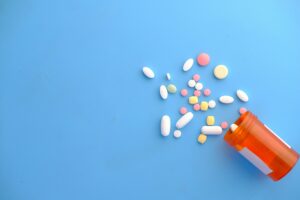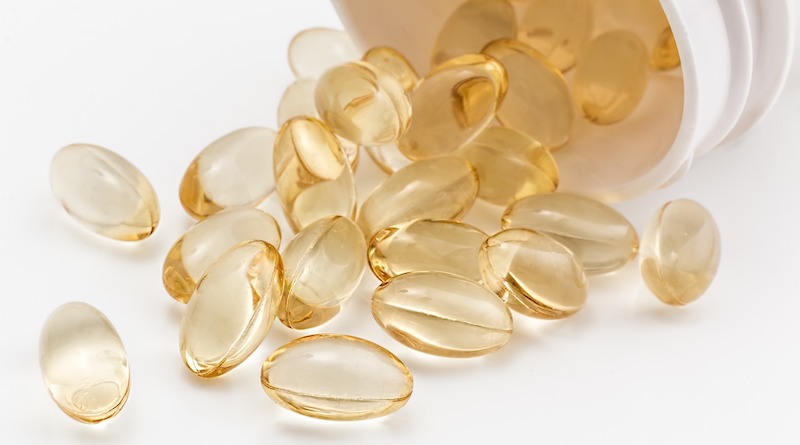
Can vitamin D supplements improve your physical health?
What’s the Deal with Vitamin D?
Are you one of the 76% of Americans who take dietary supplements (1)? Well, recently we got some bad news that one popular supplement, vitamin D, doesn’t prevent heart disease or cancer (2). But don’t ditch your D pills yet! Some research has found that vitamin D supplements may be able to help with other things, like mobility, as we age. The jury is still out though, so let’s take a closer look…
First, a little background on vitamin D (VD) and your health: One major job for VD is to help absorb dietary calcium, which is then used to maintain our bones and allow for muscle movement (3, 4). However, as we age, hormonal changes, decreased physical activity, increased inflammation, and poor nutrition can all contribute to bone density loss and muscle weakness (5). These two factors–bone health and muscle strength–influence mobility in people of all ages. So, why not just give adults VD supplements to protect their bones and improve mobility? Well, current research shows mixed results, and it’s not clear if the effect of VD differs as we age.
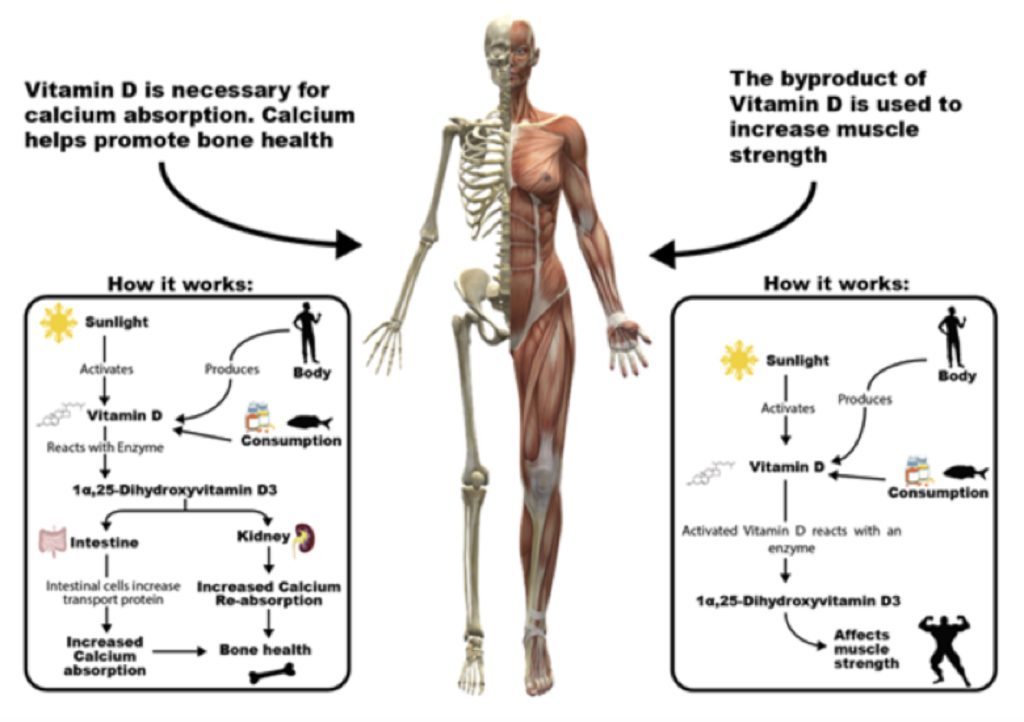
We took a closer look at some of the research on how VD affects mobility in adults of all ages to help you decide if VD supplements are right for you, and how much you might take if they are. Let’s start by breaking down the research we found into two categories: VD’s effects on bone health and muscle strength.
Bone Health
Bone health is important, because the risk for falls increases as we age—and falls can cause serious problems (7). But there is good news! If you look at most of the research on VD and bone health, it seems that VD supplementation may help at any age. Most of the studies we’ll cover below show that bone mineral density (BMD), how strong your bones are, improves with VD, especially in those over 65. And in older adults, about 800 IU of VD (roughly the amount in a standard supplement) seems to decrease fall rates significantly. Here’s some of the evidence:
Under 65: Out of three studies in younger adults (9-11), two found that BMD increased by 2% on VD, while the third showed no change (9-11). The two positive studies gave 115 total subjects an average of 600 IU of VD/1000 mg calcium (10,11). Interestingly, the study that found no change used a higher, 2000 IU dose. Thus, around 600 IU of VD may be optimal to improve BMD in younger adults. However, only two studies showed this, so more research may be needed.
Over 65: We took a look at three trials in older adults and found that VD supplementation increased BMD by an average of 1% in all of them (12-14). These studies had a total of 268 people, both VD deficient and not, who were given 400-880 IU of VD (12-14). And just like in the studies in younger adults, it seems that for adults over 65, a higher dose may also not be beneficial, because one study compared 880 IU to 1600 IU and found no improvements with the higher dose (14).
Speaking of dosages, if we look at both age groups together, the best dose to increase BMD in adults seems to be around 600 IU. Now, let’s see if this is similar for fall rates…
Fall rates over 65: There have been at least seven studies on VD and fall rates. Five of them, which included 443 healthy people, showed that fall rates decreased on VD, sometimes by as much as 60%. The trials were generally longer, lasting up to 45 weeks (15, 16, 18–20). Interestingly, four of the five used a similar 800-1000 IU VD dosage combined with 1000 mg of calcium and found similar results (15, 16, 19, 20). The other two studies used mega-doses of either one-time 600,000 IU or monthly 60,000 IU and found either no change or, even worse, a slight increase in falls (17, 21). So, the evidence does seem to suggest that 800-1000 IU may be the optimal dosage to reduce fall rates, and once again, high-doses may not be best.
What about Muscle Strength?
We did find some studies that looked at muscle strength. They mostly tested either upper limb muscles (usually grip strength) or lower limb muscles (usually leg strength). Here’s a summary of the findings:
Under 65: There have been several studies on muscle strength in healthy adults under 65 (23-27). Two of them found no effect of VD on grip strength (24, 26). However, the other 3 studies found improvements in leg strength (23, 25, 27). Two of the three studies tested squat and knee extension exercises and found a ~6% increase in performance on these strength tests (25, 27). The third study used a different Chair Sit-to-Stand test—which tests how many times you can rise from a sitting position in 30 seconds—and found a 25% improvement in test scores after VD supplementation (23). The difference in the sizes of the strength effects in these studies could be due to different test methods, but regardless of test type, it does appear that leg strength improves for adults under 65 with VD supplements.
Over 65: At least eight studies have examined muscle strength in adults over 65: three tested hand muscles and five tested leg muscles (18, 21, 28-33). Two of the three grip strength trials showed no changes (18, 30). In the third trial, grip strength even decreased by a bit when researchers used a super high 150,000 IU dose every three months (28). So, similarly to people under 65, VD may not improve grip strength in older adults, and higher doses may even be harmful. However, there is better evidence that VD may strengthen our legs. Leg strength improved by 5-20% in three studies involving a total of 223 subjects (31-33). The other two studies found no improvements, but they used either a very small 20 IU daily dose or a single 600,000 IU dose, which could explain the different results (21, 29).
Again, if we take a closer look across both age groups, the optimal dose to improve muscle strength seems to be around 1000-5000 IU. This average dosage strengthened leg muscles for both groups, especially adults over 65. However, the same cannot be said about hand muscles because researchers almost unanimously found no effect of VD on grip strength. We summarized this information in the image below:
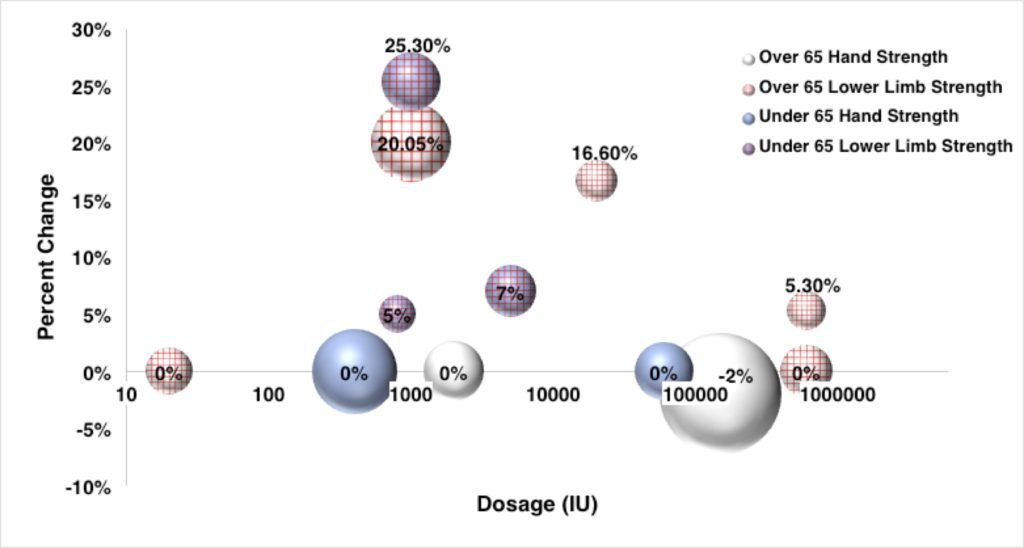
Each bubble is labeled by age group (over or under 65) and the muscle group tested. The size of the bubble reflects the number of people in a study (bigger means more).
So, to D or Not to D?
As we saw, VD may improve BMD by about 1-2% for adults of all ages. This may not seem like a lot, but our BMD worsens by about 0.4% a year for men and 1.1% per year for women (34). Furthermore, osteopenia–a deterioration of bone that is a precursor to osteoporosis–is diagnosed at 11% BMD decrease (35, 36). So, that 1-2% could actually help slow down our inevitable bone decline, especially because the studies we’ve discussed were generally shorter than a year (unfortunately, we can’t be sure what would happen long term). If that’s not convincing enough, there is significant evidence that VD decreases fall rates for adults over 65 and strengthens our legs.
We’ve summarized the data from all of the studies in the image below, in which a positive percent change for muscle strength and BMD indicates improvements. A negative percent change in fall rate is also better. As you can see, there do seem to be some beneficial effects across the board–but also some studies that show nothing:
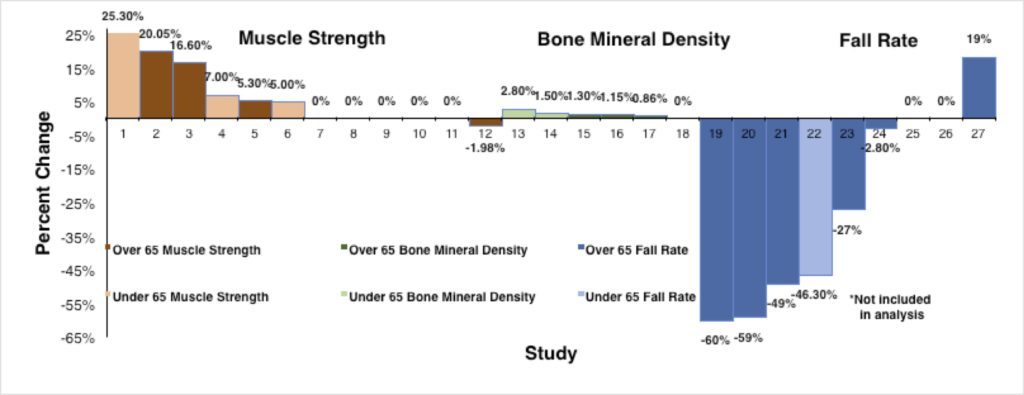
At the end of the day, physical health is a combination of muscles and bones working together–and VD supplements do seem to improve several aspects of this. Still, we can’t recommend that everyone start taking huge doses of VD, because remember, large doses had no effects or even detrimental effects across the board. But it does seem like a good idea to make sure you’re getting ~600-1000 IU of VD in your diet to maintain your physical health now and reduce the decline later. If you’re worried about not getting enough, you can get your VD levels tested to see if a supplement would be a good idea.
* VD dosage is measured in International Units, IU, because these are the units for biologically active substances. To put this into perspective, a glass of milk contains about 100 IU and the recommended daily dose for VD is about 600 IU (37).
ABOUT THE AUTHORS
Alec McCranie, Leah Rotenbakh, and Mehdi Ahmadien are students in the Integrative Physiology Department at the University of Colorado Boulder. This paper was reviewed by scientists at CU Boulder.
Review Methods
To determine how VD affects mobility over our lifetime, the authors searched PubMed and used the terms: Vitamin D combined with Mobility, Strength, Balance, and Movement. To relate to the average person, studies in subjects with any health conditions, specifically neuromuscular and genetic diseases were excluded. They found a total of 27 trials. Of these, 17 had favorable outcomes, 8 had no changes, and 2 had unfavorable outcomes. Most trials focused on either bone health or muscle strength as it relates to mobility, so the authors also focused on these two factors. They then further divided the results into two age groups: under 65 and over 65. Generally, trials in younger adults focused more on muscle strength, whereas trials in older adults focused more on bone health because there is evidence that bone mass rapidly deteriorates after age 60 (6). Additionally, many studies used a combination of VD and calcium. The authors included these trials because usually VD supplements are prescribed with calcium, so it is more relevant to look at than VD supplementation on its own. Although most studies tested muscle strength and bone health, researchers used a variety of tests. So, to make the results easier to compare between studies, the authors selected one test that had the most significant result in each study and found the percent change from baseline.
References
- 2017 CRN Consumer Survey on Dietary Supplements | Council for Responsible Nutrition. https://www.crnusa.org/resources/2017-crn-consumer-survey-dietary-supplements. Accessed December 13, 2018.
- Manson JE, Cook NR, Lee I-M, et al. Vitamin D Supplements and Prevention of Cancer and Cardiovascular Disease. N Engl J Med. November 2018:NEJMoa1809944. doi:10.1056/NEJMoa1809944
- Bell TD, Demay MB, Burnett-Bowie S-AM. The biology and pathology of vitamin D control in bone. J Cell Biochem. 2010;111(1):7-13. doi:10.1002/jcb.22661
- Ceglia L. Vitamin D and its role in skeletal muscle. Curr Opin Clin Nutr Metab Care. 2009;12(6):628-633. doi:10.1097/MCO.0b013e328331c707
- Curtis E, Litwic A, Cooper C, Dennison E. Determinants of Muscle and Bone Aging. J Cell Physiol. 2015;230(11):2618-2625. doi:10.1002/jcp.25001
- Novotny SA, Warren GL, Hamrick MW. Aging and the muscle-bone relationship. Physiology (Bethesda). 2015;30(1):8-16. doi:10.1152/physiol.00033.2014
- Xu J, Murphy SL, Kochanek KD, Bastian B, Arias E. National Vital Statistics Reports Volume 67, Number 5 July 26, 2018, Deaths: Final Data for 2016. Vol 67.; 2018. https://www.cdc.gov/. Accessed December 13, 2018.
- Cangussu LM, Nahas-Neto J, Orsatti CL, et al. Effect of isolated vitamin D supplementation on the rate of falls and postural balance in postmenopausal women fallers. Menopause. 2016;23(3):267-274. doi:10.1097/GME.0000000000000525
- Pop LC, Sukumar D, Schneider SH, et al. Three doses of vitamin D, bone mineral density, and geometry in older women during modest weight control in a 1-year randomized controlled trial. Osteoporos Int. 2017;28(1):377-388. doi:10.1007/s00198-016-3735-z
- Mehlenbeck RS, Ward KD, Klesges RC, Vukadinovich CM. A pilot intervention to increase calcium intake in female collegiate athletes. Int J Sport Nutr Exerc Metab. 2004;14(1):18-29. http://www.ncbi.nlm.nih.gov/pubmed/15129927. Accessed December 12, 2018.
- Daly RM, Bass S, Nowson C. Long-term effects of calcium–vitamin-D3-fortified milk on bone geometry and strength in older men. Bone. 2006;39(4):946-953. doi:10.1016/j.bone.2006.04.003
- Bunout D, Barrera G, Leiva L, et al. Effects of vitamin D supplementation and exercise training on physical performance in Chilean vitamin D deficient elderly subjects. Exp Gerontol. 2006;41(8):746-752. doi:10.1016/j.exger.2006.05.001
- Dawson-Hughes B, Harris SS, Krall EA, Dallal GE. Effect of Calcium and Vitamin D Supplementation on Bone Density in Men and Women 65 Years of Age or Older. N Engl J Med. 1997;337(10):670-676. doi:10.1056/NEJM199709043371003
- Verschueren SM, Bogaerts A, Delecluse C, et al. The effects of whole-body vibration training and vitamin D supplementation on muscle strength, muscle mass, and bone density in institutionalized elderly women: A 6-month randomized, controlled trial. J Bone Miner Res. 2011;26(1):42-49. doi:10.1002/jbmr.181
- Bischoff HA, Stähelin HB, Dick W, et al. Effects of Vitamin D and Calcium Supplementation on Falls: A Randomized Controlled Trial. J Bone Miner Res. 2003;18(2):343-351. doi:10.1359/jbmr.2003.18.2.343
- Bischoff-Ferrari HA, Conzelmann M, Stähelin HB, et al. Is fall prevention by vitamin D mediated by a change in postural or dynamic balance? Osteoporos Int. 2006;17(5):656-663. doi:10.1007/s00198-005-0030-9
- Bischoff-Ferrari HA, Dawson-Hughes B, Orav EJ, et al. Monthly High-Dose Vitamin D Treatment for the Prevention of Functional Decline. JAMA Intern Med. 2016;176(2):175. doi:10.1001/jamainternmed.2015.7148
- López-Torres Hidalgo J, Grupo ANVITAD. Efecto del calcio y la vitamina D en la reducción de caídas de las personas mayores: ensayo clínico aleatorizado frente a placebo. Med Clin (Barc). 2014;142(3):95-102. doi:10.1016/j.medcli.2012.11.025
- Pfeifer M, Begerow B, Minne HW, Suppan K, Fahrleitner-Pammer A, Dobnig H. Effects of a long-term vitamin D and calcium supplementation on falls and parameters of muscle function in community-dwelling older individuals. Osteoporos Int. 2009;20(2):315-322. doi:10.1007/s00198-008-0662-7
- Sato Y, Iwamoto J, Kanoko T, Satoh K. Low-Dose Vitamin D Prevents Muscular Atrophy and Reduces Falls and Hip Fractures in Women after Stroke: A Randomized Controlled Trial. Cerebrovasc Dis. 2005;20(3):187-192. doi:10.1159/000087203
- Dhesi JK, Jackson SHD, Bearne LM, et al. Vitamin D supplementation improves neuromuscular function in older people who fall. Age Ageing. 2004;33(6):589-595. doi:10.1093/ageing/afh209
- Uusi-Rasi K, Patil R, Karinkanta S, et al. A 2-Year Follow-Up After a 2-Year RCT with Vitamin D and Exercise: Effects on Falls, Injurious Falls and Physical Functioning Among Older Women. Journals Gerontol Ser A. 2017;72(9):1239-1245. doi:10.1093/gerona/glx044
- Cangussu LM, Nahas-Neto J, Orsatti CL, Bueloni-Dias FN, Nahas EAP. Effect of vitamin D supplementation alone on muscle function in postmenopausal women: a randomized, double-blind, placebo-controlled clinical trial. Osteoporos Int. 2015;26(10):2413-2421. doi:10.1007/s00198-015-3151-9
- Knutsen K V., Madar AA, Lagerløv P, et al. Does Vitamin D Improve Muscle Strength in Adults? A Randomized, Double-blind, Placebo-controlled Trial Among Ethnic Minorities in Norway. J Clin Endocrinol Metab. 2014;99(1):194-202. doi:10.1210/jc.2013-2647
- Close GL, Russell J, Cobley JN, et al. Assessment of vitamin D concentration in non-supplemented professional athletes and healthy adults during the winter months in the UK: implications for skeletal muscle function. J Sports Sci. 2013;31(4):344-353. doi:10.1080/02640414.2012.733822
- Goswami R, Vatsa M, Sreenivas V, et al. Skeletal Muscle Strength in Young Asian Indian Females after Vitamin D and Calcium Supplementation: A Double-Blind Randomized Controlled Clinical Trial. J Clin Endocrinol Metab. 2012;97(12):4709-4716. doi:10.1210/jc.2012-2340
- Apaydin M, Can AG, Kizilgul M, et al. The effects of single high-dose or daily low-dosage oral colecalciferol treatment on vitamin D levels and muscle strength in postmenopausal women. BMC Endocr Disord. 2018;18(1):48. doi:10.1186/s12902-018-0277-8
- Glendenning P, Zhu K, Inderjeeth C, Howat P, Lewis JR, Prince RL. Effects of three-monthly oral 150,000 IU cholecalciferol supplementation on falls, mobility, and muscle strength in older postmenopausal women: A randomized controlled trial. J Bone Miner Res. 2012;27(1):170-176. doi:10.1002/jbmr.524
- GRADY D, HALLORAN B, CUMMINGS S, et al. 1,25-Dihydroxyvitamin D 3and Muscle Strength in the Elderly: A Randomized Controlled Trial*. J Clin Endocrinol Metab. 1991;73(5):1111-1117. doi:10.1210/jcem-73-5-1111
- Lagari V, Gómez-Marín O, Levis S. The role of vitamin D in improving physical performance in the elderly. J Bone Miner Res. 2013;28(10):2194-2201. doi:10.1002/jbmr.1949
- Tellioglu A, Basaran S, Guzel R, Seydaoglu G. Efficacy and safety of high dose intramuscular or oral cholecalciferol in vitamin D deficient/insufficient elderly. Maturitas. 2012;72(4):332-338. doi:10.1016/j.maturitas.2012.04.011
- Songpatanasilp T, Chailurkit L-O, Nichachotsalid A, Chantarasorn M. Combination of alfacalcidol with calcium can improve quadriceps muscle strength in elderly ambulatory Thai women who have hypovitaminosis D: a randomized controlled trial. J Med Assoc Thai. 2009;92 Suppl5:S30-41. http://www.ncbi.nlm.nih.gov/pubmed/19894330. Accessed December 12, 2018.
- Zhu K, Austin N, Devine A, Bruce D, Prince RL. A Randomized Controlled Trial of the Effects of Vitamin D on Muscle Strength and Mobility in Older Women with Vitamin D Insufficiency. J Am Geriatr Soc. 2010;58(11):2063-2068. doi:10.1111/j.1532-5415.2010.03142.x
- O’Flaherty EJ. Modeling Normal Aging Bone Loss, with Consideration of Bone Loss in Osteoporosis. Toxicol Sci. 2000;55(1):171-188. doi:10.1093/toxsci/55.1.171
- Yu E, Rosen C, Mulder J. Patient education: Bone density testing (Beyond the Basics) – UpToDate. UpToDate. https://www.uptodate.com/contents/bone-density-testing-beyond-the-basics. Published 2017. Accessed December 12, 2018.
- Bone densitometry (T and Z Scores). http://courses.washington.edu/bonephys/Graphs/opbmdtz.html. Accessed December 14, 2018.
- Vitamin D — Health Professional Fact Sheet. https://ods.od.nih.gov/factsheets/VitaminD-HealthProfessional/. Accessed December 16, 2018.

